Crafting compelling Amazon stories is an art that can significantly boost your product sales and visibility. By understanding the key elements of storytelling and how to apply them effectively, you can capture your audience’s attention and convert them into loyal customers. This guide will explore crucial aspects of creating captivating stories on Amazon, with practical tips and examples to help you succeed.
Table of Contents
Understanding the Power of Amazon Stories
Amazon Stories hold a unique potential for connecting with your audience on an emotional level. These narratives can significantly enhance customer engagement, leading to higher conversion rates and brand loyalty. By weaving a story around your product, you allow potential buyers to envision how your product fits into their lives. Amazon Stories foster a deeper connection compared to traditional product descriptions by tapping into the universal love for storytelling. Establishing relatable characters, a clear conflict, and a satisfying resolution can turn casual browsers into committed buyers.
Emphasizing authenticity and clarity is crucial. Potential buyers are more likely to engage with and trust brands that present genuine stories reflecting their values and experiences. Integrate testimonials, customer reviews, and behind-the-scenes content to enrich your story. Data-driven insights can guide which elements resonate most with your audience, ensuring your story remains relevant and captivating.
Essential Elements of a Compelling Story

One of the most vital components of crafting a compelling story is understanding your audience. Knowing who your readers are and what they care about can guide every part of your narrative. Focus on creating characters that resonate with your target market. This will make your story more relatable and engaging.
Conflict and Resolution
are essential to drive your storyline. Conflict creates tension, keeps readers interested, and propels the narrative forward. In Amazon stories, the conflict may revolve around problem-solving elements relevant to the audience’s needs or desires.
Emotional Connection
is crucial for a compelling story. Whether it’s joy, fear, or excitement, emotions make your story memorable. Share experiences that evoke feelings, using vivid descriptions and scenarios your audience can visualize.
Specific Elements
like a clear beginning, middle, and end structure help keep your story organized and understandable. This structure allows your readers to follow the narrative easily without getting lost.
Visual and Sensory Details
enrich your story. Describe scenes with colors, sounds, and textures to make the narrative vibrant and interactive. Such details can create a more immersive experience for your readers.
How to Use Storytelling to Boost Amazon Sales
Understanding the Power of Amazon Stories
Effective storytelling on Amazon can transform your product listings from mundane to mesmerizing. Stories resonate with consumers, creating emotional connections that drive engagement and sales. In a crowded marketplace, captivating stories set your brand apart, fostering loyalty and trust.
Essential Elements of a Compelling Story
The most compelling stories have key elements: a relatable protagonist, a challenge or problem, a solution your product provides, and a positive resolution. Relating these elements to your audience’s desires and pain points can create a powerful narrative.
How to Use Storytelling to Boost Amazon Sales
Using storytelling in your Amazon listings involves weaving a cohesive narrative that highlights your product’s unique benefits. Employ attention-grabbing openings, detailed descriptions, and emotional triggers that resonate with potential buyers. Engage your audience with a storyline that emphasizes how your product solves their problems and enhances their lives.
Tips for Writing Engaging Product Descriptions
Craft descriptions that are not only informative but also engaging. Use sensory words and vivid imagery to paint a picture of the product in use. Incorporating customer testimonials and reviews can add authenticity and credibility to your narrative.
Case Studies of Successful Amazon Stories
Analyze case studies of brands that have successfully used storytelling to their advantage on Amazon. Look for common strategies and tactics they used, such as focusing on customer experiences and building a strong brand narrative.
Common Mistakes to Avoid in Amazon Storytelling
Avoid overloading your descriptions with jargon or irrelevant information. Don’t neglect the importance of a clear, concise, and cohesive storyline. Ensure your story aligns with your brand’s voice and message without deviating from the core benefits of your product.
Tools and Resources for Crafting Amazon Stories
Utilize tools like keyword research platforms, content generators, and feedback analytics to fine-tune your storytelling approach. These resources can provide insights into what resonates with your audience and how you can improve your narrative.
Future Trends in Amazon Storytelling
Stay ahead by exploring emerging trends in storytelling, such as interactive content, video stories, and user-generated content. As technology evolves, new storytelling methods will continue to emerge, offering fresh ways to engage and convert your audience. Use these strategies to craft compelling stories that captivate and convert on Amazon.
Tips for Writing Engaging Product Descriptions

When you’re crafting product descriptions for your Amazon listings, the key is to directly involve the customer by making the text engaging and relatable.
Understand Your Audience
Tailor your descriptions to match the interests and needs of your target audience. Use language and terms that resonate with them.
Focus on Benefits, Not Just Features
Rather than just listing features, explain how these features will benefit the user. This could involve solving a problem or making their life easier. For instance, instead of saying “water-resistant,” you could say “keeps your belongings safe and dry during unexpected weather.”
Use Sensory Words
Sensory words help customers imagine the product experience. Words like “velvety,” “sparkling,” and “crisp” can paint a vivid picture of what to expect.
Tell a Mini Story
Incorporate a brief story that demonstrates the product in use. This can help the customer visualize the product fitting seamlessly into their daily routine. For example, “Imagine enjoying a cup of coffee on a rainy day, knowing that your waterproof bag is keeping all your essentials dry and safe.”
Be Concise Yet Detailed
Providing detailed information doesn’t mean writing a novel. Balance the need for detail with brevity. Use bullet points to break down complex information into easy-to-read sections.
Incorporate Keywords Naturally
Make sure relevant keywords are woven naturally throughout the description. Avoid keyword stuffing which can make the text difficult to read and penalized by search engines.
Include High-Quality Images
While text is crucial, pairing it with high-quality images can significantly enhance engagement. Visuals provide a real-life context and help in understanding the product better.
Use Social Proof
Incorporate reviews or testimonials within the description. A mention of any awards or recognitions the product has received can also add credibility.
Create a Sense of Urgency
Prompt quicker purchasing decisions by creating a sense of urgency. Phrases like “limited stock” or “special offer until” can compel customers to act swiftly.
Case Studies of Successful Amazon Stories
Case Study 1: XYZ Company
XYZ Company leveraged the power of storytelling to transform their Amazon sales. By focusing on the customer’s journey and the unique benefits of their product, they were able to increase their conversion rates by 35%. Their story included customer testimonials, behind-the-scenes looks at the production process, and a strong emotional appeal.
Case Study 2: ABC Electronics
ABC Electronics used storytelling to highlight the innovative features of their new gadget. They created a series of stories showing different use cases and real-life applications. This approach not only boosted their product’s visibility but also built a loyal customer base. The key was in connecting emotionally with the audience through relatable narratives.
Case Study 3: Green Earth Goods
Green Earth Goods focused on their commitment to sustainability in their Amazon stories. They shared detailed narratives about their eco-friendly practices and how their products support a greener lifestyle. This transparency and authenticity resonated with eco-conscious consumers, leading to a 50% increase in sales within six months.
Case Study 4: BrightHome Decor
BrightHome Decor’s storytelling strategy centered on home transformation. They showcased before-and-after scenarios, customer stories, and expert tips. By personalizing their content and showing the real impact of their products, they connected deeply with their target audience, resulting in a 40% rise in customer engagement and repeat purchases.
Case Study 5: FitLife Supplements
FitLife Supplements crafted a narrative that focused on health and wellness journeys. They shared inspiring customer success stories and expert advice on achieving fitness goals. This approach not only built trust but also positioned them as a trusted authority in the health niche, leading to a significant boost in brand loyalty and sales.
Common Mistakes to Avoid in Amazon Storytelling

Neglecting the Target Audience: One of the most frequent errors is not tailoring your story to your specific audience. Understanding their preferences, pain points, and desires is crucial.
Overloading with Information: Bombarding potential customers with too much data can overwhelm them. Focus on key points that highlight the benefits and unique features of your product.
Ignoring Emotional Appeal: Stories that don’t evoke emotions fall flat. Make sure your narrative connects on a personal level to create a memorable experience.
Lack of Consistency: Ensure that your story aligns consistently with your brand’s voice and message across all platforms. Inconsistencies can confuse and deter your audience.
Poor Visuals: High-quality images and videos are essential. Low-resolution visuals can detract from your story and make your product look unprofessional.
Skipping User Experience (UX): A seamless and engaging UX is vital. Clunky layouts and difficult navigation can turn potential customers away.
Overcomplicating the Narrative: Keep your story straightforward and easy to follow. Overly complex narratives can lose reader interest quickly.
Forgetting to Highlight Benefits: Ensure that your story clearly showcases how the product will solve problems or improve the customer’s life. Highlighting benefits over features can drive conversions.
Not Updating Stories: Stale content drives users away. Regularly update your stories to keep them fresh and relevant, ensuring you maintain engagement with your audience.
Tools and Resources for Crafting Amazon Stories
When diving into the world of Amazon storytelling, having the right tools and resources at your disposal can make a significant difference. Below are some essential tools that can enhance your storytelling efforts and help you create compelling narratives:
Keyword Research Tools
Utilizing keyword research tools like Ahrefs or SEMrush allows you to identify the terms and phrases your target audience uses. This ensures your story is discoverable and resonates with potential customers searching for similar products.
Graphic Design Software
Programs such as Canva or Adobe Spark are invaluable for creating visually appealing images and infographics that can complement and strengthen your Amazon story. High-quality visuals can significantly enhance the overall impact of your narrative.
Video Editing Tools
Incorporating video elements in your story can dramatically increase engagement. Tools like iMovie or Adobe Premiere Pro enable you to create professional-quality videos that showcase your product in a more dynamic and engaging way.
Content Management Systems
A strong CMS, such as WordPress or HubSpot, can help you organize and streamline your content creation process. These platforms often include SEO tools that ensure your stories are optimized for search engines.
Review Management Software
Collecting and analyzing customer reviews through tools like Trustpilot or Yotpo can provide valuable insights into how your audience perceives your story and product, allowing you to make data-driven improvements.
Leverage these tools to craft Amazon stories that not only captivate but also convert. Experiment with different combinations and find the mix that best suits your style and needs.
Future Trends in Amazon Storytelling

The landscape of Amazon storytelling is continuously evolving. Staying ahead means understanding and adopting the latest trends. One significant trend is the growing importance of interactive and immersive content. Shoppers are looking for more engaging experiences, and brands are responding with rich media such as videos, 3D images, and interactive features.
Another trend is the increased focus on authenticity and transparency. Consumers are becoming more skeptical, and they value stories that feel genuine. Sharing behind-the-scenes content, customer testimonials, and real-life applications of the product can help build trust.
Additionally, there’s a shift towards personalized storytelling. With data analytics and AI, brands can craft stories that cater to individual shopper preferences and behaviors. Personalized stories can significantly enhance the customer experience and improve conversion rates.
The use of ephemeral content is also on the rise. Stories that are available for a limited time create a sense of urgency and exclusivity, encouraging quicker purchasing decisions.
Lastly, integrating social proof into your stories can be a game-changer. Featuring user-generated content, reviews, and ratings can make your story more relatable and persuasive.


